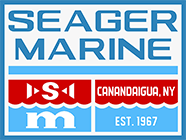Life Jacket Guide - What Kind Of Life Jacket Is Right For Me?
Jul. 22 2019
Boats
 Do you need a new life jacket, but don’t know where to start? Here is some information to help you pick the right jacket to keep you floating this summer.
Do you need a new life jacket, but don’t know where to start? Here is some information to help you pick the right jacket to keep you floating this summer.
1.) Who Needs to Where A Life Jacket?
- Children under the age of 12 aboard a boat less than 65 feet in length, canoes, kayaks or rowboats unless in a totally enclosed cabin
- Everyone being towed (wakeboarding, water skiing, tubing, etc.)
- Everyone aboard a boat less than 21 feet in length, including rowboats, canoes, and kayaks, while underway between November 1st and May 1st
- Everyone aboard a Personal WaterCraft (PWC)
2.) What Kind of Life Jacket Do I Need?
This can vary from state to state, but here in In NY State, a wearable life jacket it required for every person aboard the boat. These life jackets must be:
- U. S. Coast Guard approved
- The proper size for the intended wearer
- In good and serviceable condition
- Properly stowed (readily accessible)
3.) Are There Different Types of Life Jackets? And Which Type Do I Need?
- There are five different types of Life Jackets available, each with its own intended purpose. A type III Life Jacket is most common for water sports and recreational boating, but it is helpful to understand all five types and their intended purposes.
- Type I: Intended Use - When cruising, racing and fishing offshore , or when boating alone, or in stormy conditions. Best for open, rough or remote water where rescue may be slow to arrive. Will turn MOST unconscious wearers face-up in water. Offers the best protection, but is somewhat bulky and uncomfortable. Does the best job of retaining body heat, as it has additional foam and fabric, and keeps your head higher above water. Currently, there aren't any Coast Guard approved Type I inflatable PFD's available to the general public.
- Type II: Intended Use - Inland day cruising, fishing and sailing. Good for boating in light craft. Good for protected, inland water near shore, where chances of immediate rescue is good. Not suitable for extended survival in rough water. Will turn SOME unconscious wearers face-up in water. Poor performer in rough water, often requires you to tread water in order to keep your head above water. More comfortable but less buoyant than Type I. Provides far less flotation than a Type I
- Type III: Intended Use - Supervised activities, such as sailing regattas, dinghy races, water skiing, fishing, canoeing, kayaking and during personal watercraft operation.Good for protected, inland water near shore, where chance of immediate rescue is good. (BEST FOR WATER SPORTS AND RECREATION!)
- Type IV: Throwable Device - Intended Use - A Type IV is designed to be thrown to an overboard victim or to supplement the buoyancy of a person overboard. It is not to be worn. A Type IV throwable device can be a square style, or a ring buoy or horseshoe buoy mounted on deck. A Type IV is not for unconscious persons, non-swimmers or children. Although these devices are often referred to as seat cushions, you should never use it as such. This degrades the foam and reduces the amount of floatation that is provided. NOTE - Type IV devices must be IMMEDIATELY AVAILABLE for use. You must have one at arm's length to throw over the side in an emergency. Having one in a locker under the driver's seat isn't considered "immediately available."
- ype V: Special use life jackets - Intended Use - Restricted to the special use for which each is designed, for example: sailboard harness, deck suit, paddling vest, commercial white water vest or float coats. Must be worn when underway to meet minimum US Coast Guard requirements. Simply having a Type V PFD on board will not meet the USCG carriage requirements.
4.) How Do I Know What Size Life Jacket I Need?
- If your life jacket fits properly, It will help keep your head above the water. Too big, and the life jacket will ride up around your face. Too small, it will not be able to keep your body afloat. To make sure that you choose the correct fitting life jacket for you, we recommend trying them on for size. When doing so, run through the following steps:
- Check the manufacturer’s label to ensure that the life jacket is a proper fit for your size and weight.
- Make sure the jacket is properly fastened.
- Hold your arms straight up over your head.
- Ask a friend to grasp the tops of the arm openings and gently pull up.
- Make sure there is no excess room above the openings and that the jacket does not ride up over your chin or face.
For additional tips for how to stay safe on the water this summer, make sure to check out our Seager Marine blog post “Boat Safely in NY State” .
